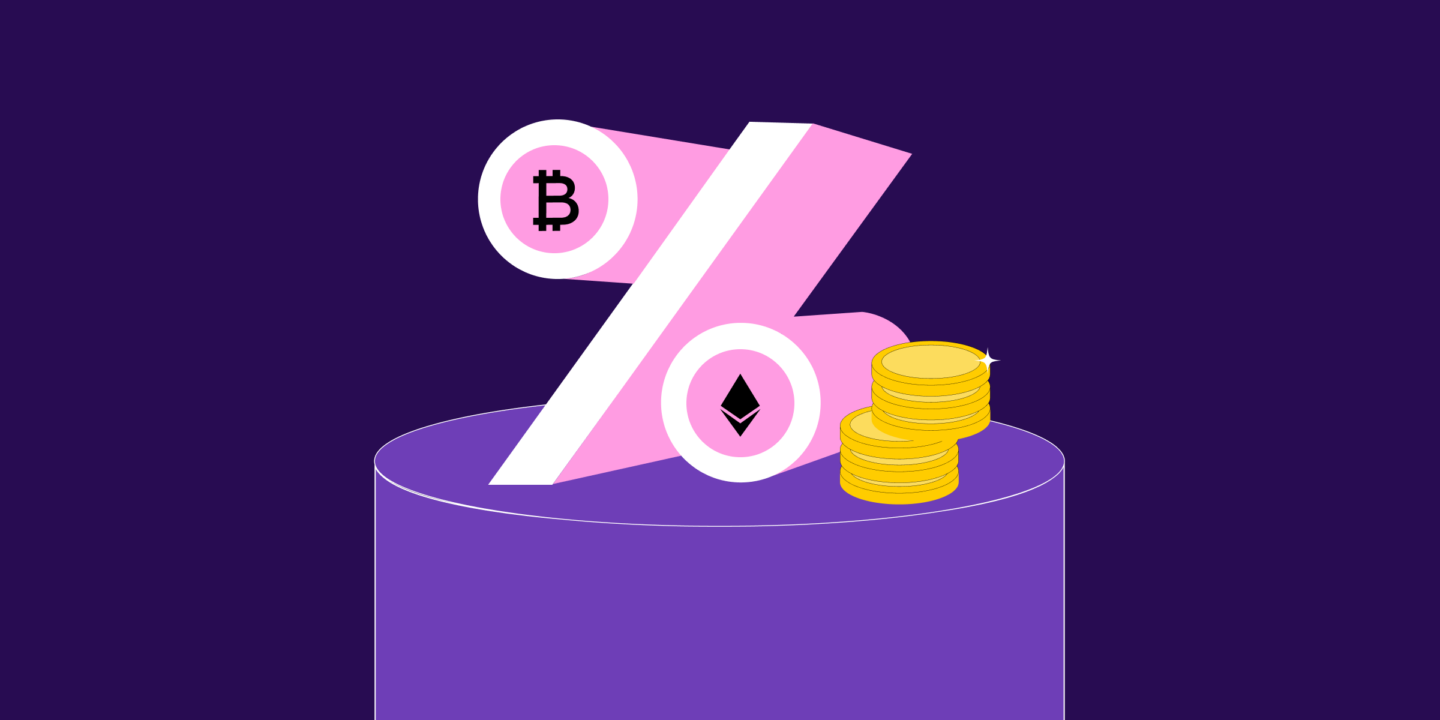
Have you ever wondered how to measure the true earning potential of your crypto holdings? Enter APY, the magic number that indicates the total returns earned on your investment. From staking pools to lending platforms, crypto APYs can range from modest to the downright stratospheric rate.
But what does a good APY look like? And how can you make sure you’re getting the most out of your crypto investments?
Join us as we delve into what APY is in the crypto universe.
Annualized Percentage Yield (APY) in Crypto: What Is it?
In simple terms, Annualized Percentage Yield (APY) is a metric that describes the annual interest rate earned on an investment.
From a crypto perspective, APY describes the rate of return on a crypto investment, such as a staking or lending program. It is mainly calculated based on the interest rate and compounding frequency (e.g., daily, weekly, monthly, or yearly).
Let’s assume you deposit 1 BTC into a staking program with an APY of 10%, and the program compounds interest annually. In such a case, you will have earned an additional 0.10 BTC in interest after one year.
Understanding APY is important for investors as it helps them to compare different investment opportunities and make informed decisions about where to invest their money.
How Does APY Work?
APY works by taking into account the interest rate earned on an investment and the frequency of compounding.
Compounding refers to earning interest on an asset and then earning interest on that interest over time. The more frequently the interest is compounded, the higher the APY will be.
For example, if an investment earns 10% interest per year, the APY would be 10%. But, if the interest is compounded daily, the APY would be higher than 10%. It’s because each day, the interest earned is added back to the principal, and you make interest on top of that interest and so on.
APY can be a valuable metric for investors to compare different investment opportunities. It allows them to see the potential return on an investment over a year after considering the compounding effect.
But it’s important to note that APY is just a theoretical number. It may not reflect the actual returns an investor would receive. It does not consider potential fees, taxes, and other factors that may affect the return on investment.
Factors Affecting Crypto APY
Several factors can affect the APY of crypto investment.
1. Inflation
From a traditional economic perspective, inflation is the loss of the intrinsic value of currency over time. In the crypto world, inflation is the rate at which new coins are added to the network.
Cryptos with higher inflation rate erodes in value due to a rapidly increasing (net) supply of coins into the market and vice versa. Thus, if cryptos have a higher inflation rate than their APY, the real or net returns would be negligible.
2. Compounding frequency
The more frequently interest is compounded, the higher the APY will be.
3. Supply and demand
Like any market, supply and demand affect the price of a cryptocurrency. A crypto holder can lend their asset to others to earn interest. The interest rate depends on how much demand there is to borrow it.
When demand is high, and supply is low, the interest rate for borrowing a crypto is usually higher and vice versa. Thus, the specific APY for a crypto can fluctuate based on demand and liquidity.
4. Network conditions
The performance of the blockchain network also affects the APY. Suppose the network is congested and has high fees; it may affect the staking or lending program’s ability to compound interest and, thus, lower the APY.
5. Security measures and platform reputation
Security measures and platform reputation might not directly impact the crypto APY, but they still have some weightage.
High-security measures such as encryption, multi-factor authentication, and cold storage can increase trust in the platform, making it more attractive to potential investors and increasing the demand for the crypto. On the other hand, if security measures are weak or there are known vulnerabilities, it can decrease demand and lead to lower APYs for lenders.
Likewise, it applies to the reputation of the platform. Platforms with a good reputation are favorable for crypto APY.
How to calculate APY in Crypto?
To calculate APY in crypto, you need to know the interest rate and the compounding frequency.
The formula for APY is,
APY = ((1 + Interest Rate / Number of times compounded per year) ^ (Number of times compounded per year)) – 1
For example, let’s say you deposit 1 ETH into a staking program that offers an interest rate of ‘10%’ annually and compounds interest ‘daily.’
To calculate the APY:
- Divide the interest rate by the number of times compounded per year: (10% / 365) = 0.0002739726
- Add one to the result: (1 + 0.0002739726) = 1.0002739726
- Raise that to the power of the number of times compounded per year: (1.0002739726) ^ 365 = 1.105155781
- Subtract one from the result: (1.105155781 – 1) = 0.105155781
So the APY would be 10.52%.
It’s important to note that this is a simple example. Investors should also consider the risk level, the platform’s reputation, and the potential for loss of principal before making a decision.
APY-Involved Crypto Investments
Below are a few examples of crypto investments that involve APY.
1. Crypto staking
Staking refers to holding a certain amount of a specific crypto asset in a wallet and validating transactions on the blockchain network. In return, investors receive a percentage of the block rewards as interest. It is usually calculated using the APY.
2. Crypto lending
Crypto lending platforms allow investors to lend their assets to other users or platforms in return for interest. The APY for lending investments can vary depending on the platform and the type of assets being lent.
3. Yield farming
Yield farming is a type of investment strategy where investors deposit their assets into a liquidity pool and earn interest in the form of additional tokens.
4. Deposit accounts
Some crypto platforms offer deposit accounts that allow investors to earn interest on their deposited crypto assets.
APY Vs. APR: Key Differences
We have seen what exactly an APY is. Now let’s understand the concept of APR.
APR (Annual Percentage Rate) is often used to discuss loan terms for borrowers as it measures the ‘true’ cost of borrowing money. It is expressed as a percentage of the loan amount and is typically used to compare different loan options. The APR takes into account the interest rate, origination fees, and other charges associated with the loan.
The formula for calculating is,
APR = [(Fees + Interest) ÷ Principal Amount] ÷ N × 365 × 100
N = Number of days in the loan term.
Below are the critical differences between these two.
1. Compounding frequency
APY takes into account the frequency of compounding, while APR does not. APY calculates the interest earned on an investment, including the compounding effect. But APR only calculates the simple interest rate.
2. Usage
APR is mainly used for loans and credit, such as mortgages, credit cards, and personal loans. APY is primarily used for savings and investment accounts.
3. Fees
As mentioned in the formula, the calculation of APR includes its fees component. Suppose a $1000 loan requires you to pay an annual interest payment of $100 and a one-time fee of $10. In that case, APR comes to 11%. Here, the fee amount ($10) is part of the APR.
Now let’s look at APY. Crypto investment platforms might charge a fee to its user. But, the fee component is not part of the final APY rate.
Conclusion
APY (Annual Percentage Yield) measures the interest earned on a crypto investment, including the compounding effect.
Crypto APY is often higher than traditional investments due to high-interest rates, compounding frequency, high demand, lack of regulation, and high volatility. However, proper research on the platform, company, or project is essential before making any investment decision.
FAQs
1. What does 5.00% APY mean?
Suppose you were to invest $1000 at 5.00% APY. In that case, after one year, you would earn $50 as interest over the invested amount (of $1000). Please note that APY considers the frequency of compounding. If the interest is compounded daily, the APY is higher than if the interest is compounded annually.
2. What is the meaning of APY in crypto staking?
Crypto staking refers to holding a certain amount of a specific crypto asset in a wallet and validating transactions on the blockchain network. In return, investors receive a percentage of the block rewards as interest, usually calculated using the APY.
3. How come crypto APY is so high?
Crypto APY is often higher than traditional investments because of several factors.
- High-interest rates
- Compounding frequency
- High demand
- Lack of regulation
- High volatility
But, it’s important to note that a higher APY can also mean higher risk. Thus, proper research on the platform, company, or project is essential before making any investment decision.
4. What is a good APY in crypto?
A good APY in crypto can vary depending on the specific cryptocurrency and the platform it is being offered on. Generally, an APY of 15-20% is considered good for crypto.
But it is important to remember that these numbers can change rapidly due to the volatility of the crypto market. Also, consider the risk when choosing a cryptocurrency to earn interest on. Some projects may have a higher chance of failing or being subject to scams. Thus, always do your own research and invest only what you can afford to lose.





